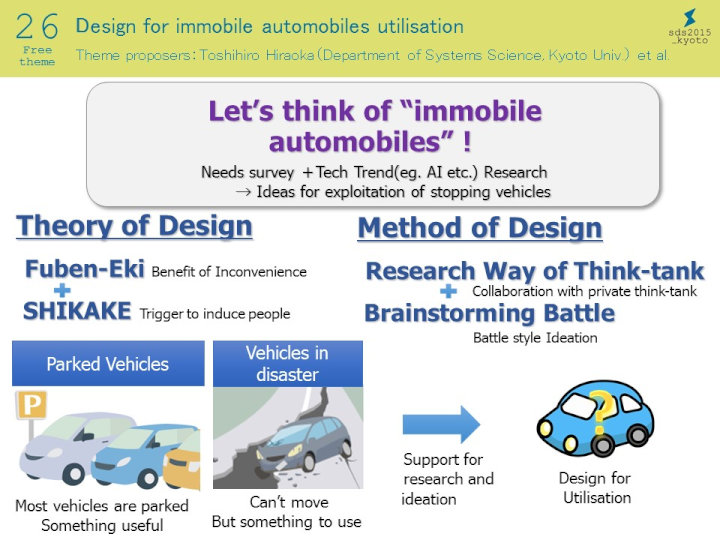26 Design for Immobile Automobile Utilization

↑click to enlarge
Let’s think about brand new service and product which people feel to compelled to use unthinkingly despite the inconvenience with striking ideas!
Organizers
| Name |
Organization |
Specialty |
| Toshihiro Hiraoka |
Department of Systems Science, Graduate School of Informatics, Kyoto University |
Human-Machine Systems |
| Noriaki Oba |
Research Department, Technova Inc. |
AI, ICT Industry |
| Atsuko Kuge |
Research Department, Technova Inc. |
Social Change, Consumer Behavior |
Overview
Vehicles are NOT rolling but parked for 96% of their lifetime (in case of the common use: drive 100,000 km at an average of 20km per hour in 10 years). Such “immobile automobiles” are mostly unexploited.
On the other hand, it is known that in times of disaster such as earthquake, tsunami or mudslide, parked vehicles are used as shelters which can tune in radio and view a navigation system, not as transportation use.
Based on these fact above, it would be worthy to rethink about “immobile automobile” utilization.
Besides, progress in ICT technology and the recent auto development trend like larger battery for EV and hybrid cars have made vehicles more likely to be used as a communication tool. Thus, there should be various new values that would not have been assumed from past experience.
On the background, we would discuss ideas with broad perspective and propose implementable utilization of parked car in both peacetime and times of disasters.
Educational Goals
Students will be provided a study of process both idea-system development and total designing, with actual social background and technological trends.
Design Theory and Design Method
[Design Theory]
HIRAOKA will have a lecture about the design policy of "Benefit of Inconvenience (Fuben-Eki)", and embodied trigger (SHIKAKE) for indirect behavior change.
OBA and KUGE will have a lecture about social background and technology trends.
[Design Method]
Ideation will be framed in terms of both divergent thinking with the 4 brainstorming principles and convergent thinking with competition among groups ("Brainstorming Battle").
Schedule
Day 1: Sept 16
Morning
- Have a lecture/Q&A about "Fuben-Eki", "SHIKAKE", social background and technological trends.
Afternoon(1)
- Trial of the battle style brainstorming (“Brainstorming Battle”) using example.
Afternoon(2)
- Gathering information about the focus subject(including hearing survey as appropriate).
Day 2: Sept 17
Morning
- "SHIKAKE" ideation using "Brainstorming Battle"
Afternoon(1)
- Idea exchanges, and consideration for implementation.
Afternoon(2)
- Refinement of the idea for presentation
Day 3: Sept 18
Morning
- Preparation for presentation.